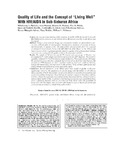| dc.description.abstract | Purpose: To increase understanding of the meaning of quality of life for people living with
HIV/AIDS in four countries in sub-Saharan Africa: Botswana, Lesotho, South Africa, and
Swaziland.
Methods: Using a cross-sectional design and convenience sample, we administered a survey
and collected data on demographic characteristics, measures of severity of illness,
and perceptions of quality of life. The purposefully selected sample (N=743) consisted
of community-based people living with HIV/AIDS in 2002. Based on the Wilson and
Cleary framework for organizing variables related to quality of life, a hierarchical multiple
regression was conducted with quality of life as the dependent variable.
Results: The sample of 743 persons was 61.2% female with a mean age of 34 years. Approximately
62% of the sample reported having received an AIDS diagnosis. Ten predictor
variables explained 53.2% of the variance in life satisfaction. Those participants with higher
life satisfaction scores were less educated, had worries about disclosure and finances, did
not have an AIDS diagnosis or other comorbid conditions, had lower symptom intensity,
had greater functioning, and had fewer health worries. None of these participants was
taking antiretroviral medications at the time of this study.
Conclusions: Several dimensions of the Wilson and Cleary model of quality of life were
significantly related to life satisfaction for people living with HIV/AIDS in sub-Saharan
Africa. Quality of life for this sample was primarily defined as overall functional ability and
control over symptom intensity. These findings are similar to studies in developed countries
that have shown the significant relationships among functional abilities, symptom control,
and perceived quality of life. As antiretroviral medications become more available in these
areas, community members and care providers can help clients realize the possibility of
living well with HIV/AIDS, and can work with clients to improve functional ability and
control symptom intensity to make living well a reality. | en_US |

